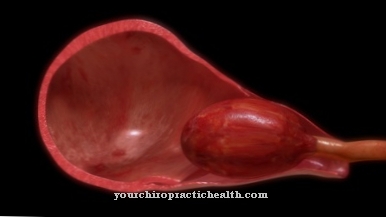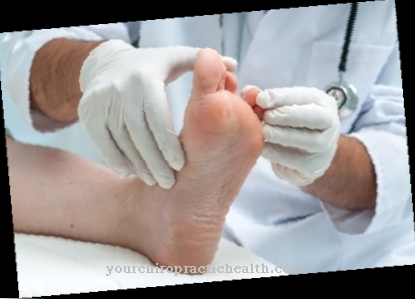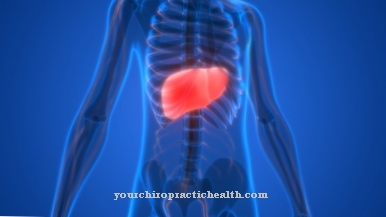Of the Euler-Liljestrand mechanism causes a contraction of the vascular muscles in the pulmonary tracts in the event of an insufficient supply of oxygen, which improves the ventilation-perfusion ratio of the lungs. The mechanism is a natural reflex that only affects the lungs. The Euler-Liljestrand mechanism is pathological at high altitudes, for example, where it promotes pulmonary edema.
What is the Euler-Liljestrand Mechanism?

During vasoconstriction, the blood vessels constrict. This narrows the cross-section of the blood vessels and changes the blood pressure. The smooth vascular muscles are responsible for vasoconstriction and, if necessary, with vasodilation also relax and thus expand the vessels. The state of tension in the vascular muscles is mediated by various substances, for example with vasoconstriction by so-called vasoconstrictors.
The Euler-Liljestrand mechanism is characterized by reflex vasoconstriction. This natural body process occurs with hypoxia, i.e. when the tissue is insufficiently supplied with oxygen. Both global and local oxygen depletion can trigger the Euler-Liljestrand reflex and thus cause a hypoxic pulmonary vasoconstriction or a hypoxic pulmonary vascular response. The reflex increases the airway resistance locally.
Vasoconstriction as part of the Euler-Liljestrand mechanism only affects the pulmonary circulation. Hypoxia causes vasodilation in all other vessels in the body. So while the pulmonary circulation contracts, all other vessels expand to allow more oxygen-carrying blood to pass through.
Function & task
The flow of blood through the lungs is local. The same goes for the degree of lung ventilation. The lung tissue is locally ventilated and perfused differently. Due to physical relationships, such as gravity, the blood flow is higher in the basal parts, so that the basal lungs have better blood flow. Because the basal lung areas are also less stretched, ventilation in these areas is also at a higher level. In direct comparison to the basal areas, the apical portions of the lung are less perfused and ventilated.
The blood circulation in particular decreases extremely from basal to apical. The ventilation also decreases, but compared to perfusion the decrease in ventilation in the apical direction is significantly less. The ventilation-perfusion quotient indicates the ratio of lung ventilation to lung perfusion and thus cardiac output. Due to the local differences between the basal and apical parts, the apical ventilation-perfusion quotient is greater than one. The basal ventilation-perfusion quotient, however, is less than one. Again, the optimal ventilation-perfusion ratio is one. This ratio is not achieved due to the local differences. The oxygen uptake of the blood therefore does not correspond to the absolute optimum.
Naturally, the differences in perfusion and ventilation in the individual lung areas mean that blood fractions, such as the intrapulmonary right-left shunt, are not supplied with oxygen. In order to break this connection, the Euler-Liljestrand mechanism reduces the affected shunts.
The reflex adapts the perfusion of the lungs to the ventilation in the relevant areas and thus improves the ventilation-perfusion quotient. The Euler-Liljestrand reflex achieves this goal with a contraction of the vascular muscles in the pulmonary circulation, which is mediated by a reduced oxygen supply.
In the case of ventilation disorders in the context of pneumonia, for example, vasoconstriction redistributes the blood through the Euler-Liljestrand mechanism. In this case, less well-ventilated sections are supplied with less blood than better-ventilated areas. In case of doubt, this effect is relevant for maintaining the oxygen supply in individual tissues and results in a redistribution of the blood.
You can find your medication here
➔ Medication for shortness of breath and lung problemsIllnesses & ailments
The Euler-Liljestrand mechanism is a natural reflex, but in certain contexts it also has negative consequences for human health. This applies, for example, to the development of pulmonary hypertension in the context of chronic obstructive bronchitis or bronchial asthma. The Euler-Liljestrand reflex plays a key role in the development of this pathological increase in vascular resistance and blood pressure in the pulmonary circulation. The vasoconstriction mediated by the reflex increases the afterload of the right heart and at the same time creates a ventricular pressure load. The heart responds to this with compensation. As a result, there is concentric hypertrophy in the right ventricle. This enlargement of the tissue in the right ventricle can result in right heart failure. With this phenomenon, the right heart no longer has sufficient pumping power to transport enough blood back into the bloodstream.
Another disease phenomenon associated with the Euler-Liljestrand mechanism is pulmonary edema of altitude sickness. Mountain climbers who move at altitudes of more than 2000 meters above sea level suffer from altitude sickness. The disease is an adjustment disorder of the organism that leads to functional disorders in the body. Athletes who start the ascent at high speed and have not previously acclimatized themselves are particularly at risk. One of the first symptoms of altitude sickness is retinopathy, in which the blood vessels in the retina protrude and thus cause a progressive reduction in vision.
The pulmonary edema only occurs in acute altitude sickness and is caused by the hypoxic vasoconstriction that the Euler-Liljestrand reflex results. The increase in perfusion pressure leads to high altitude pulmonary edema when exerting at great heights, because more fluid from the vessels of the lungs passes into the alveolar space. High lung edema is associated with acute danger to life and should be clarified and treated immediately if in doubt. High-altitude mountaineers ideally turn around when they have retinopathy and start the descent or stay at least to acclimatize at the current altitude in order to prevent the development of pulmonary edema.
























.jpg)



